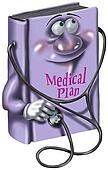

In recent years, various new types of medical plans have been introduced.
- High-deductible health plan (HDHP)
Plans with much higher deductibles than traditional health plans – primarily providing coverage for catastrophic illness – have been introduced. Because of the high deductible, these provide little coverage for everyday expenses – and thus have potentially high out-of-pocket expenses – but do cover major expenses. Couple with these are various forms of savings plans.
- Tax-preferenced health care spending account
Coupled with high-deductible plans are various tax-advantaged savings plans – funds (such as salary) can be placed in a savings plan, and then go to pay the out-of-pocket expenses. This approach to addressing increasing premiums is dubbed "consumer driven health care", and received a boost in 2003, when President George W. Bush signed into law the Medicare Prescription Drug, Improvement, and Modernization Act. The law created tax-deductible Health Savings Accounts (HSAs), untaxed private bank accounts for medical expenses, which can be established by those who already have health insurance. Withdrawals from HSAs are only penalized if the money is spent on non-medical items or services. Funds can be used to pay for qualified expenses, including doctor's fees, Medicare Parts A and B, and drugs, without being taxed.
Consumers wishing to deposit pre-tax funds in an HSA must be enrolled in a high-deductible insurance plan (HDHP) with a number of restrictions on benefit design; in 2007, qualifying plans must have a minimum deductible of US$1,050. Currently, the minimum deductible has risen to $1.200 for individuals and $2,400 for families. HSAs enable healthier individuals to pay less for insurance and deposit money for their own future health care, dental and vision expenses.
HSAs are one form of tax-preferenced health care spending accounts. Others include Flexible Spending Accounts (FSAs), Archer Medical Savings Accounts (MSAs), which have been superseded by the new HSAs (although existing MSAs are grandfathered), and Health Reimbursement Accounts (HRAs). These accounts are most commonly used as part of an employee health benefit package. While there are currently no government-imposed limits to FSAs, legislation currently being reconciled between the House of Representatives and Senate would impose a cap of $2,500. While both the House and Senate bills would adjust the cap to inflation, approximately 7 million Americans who use their FSAs to cover out-of-pocket health care expenses greater than $2,500 would be forced to pay higher taxes and health care costs.
In July 2009, Save Flexible Spending Plans, a national grassroots advocacy organization, was formed to protect against the restricted use of FSAs in health care reform efforts, Save Flexible Spending Accounts is sponsored by the Employers Council on Flexible Compensation (ECFC), a non-profit organization “dedicated to the maintenance and expansion of the private employee benefits on a tax-advantaged basis”. ECFC members include companies such as WageWorks Inc., a benefits provider based in San Mateo, California.
Most FSA participants are middle income Americans, earning approximately $55,000 annually.Individuals and families with chronic illnesses typically receive the most benefit from FSAs; even when insured, they incur annual out-of-pocket expenses averaging $4,398 .Approximately 44 percent of Americans have one or more chronic conditions .
- Limited benefit plan
Opposite to high-deductible plans are plans which provide limited benefits – up to a low level – have also been introduced. These limited medical benefit plans pay for routine care and do not pay for catastrophic care, they do not provide equivalent financial security to a major medical plan. Annual benefit limits can be as low as $2,000. Lifetime maximums can be very low as well.
- Discount medical card
One option that is becoming more popular is the discount medical card. These cards are not insurance policies, but provide access to discounts from participating health care providers. While some offer a degree of value, there are serious potential drawbacks for the consumer.
No comments:
Post a Comment